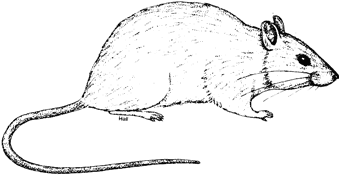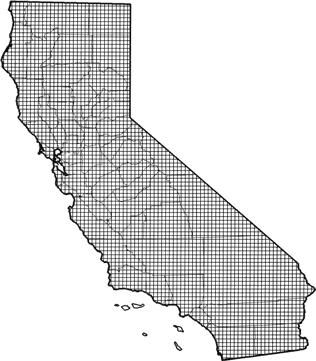
House Mouse
Distribution, Abundance, and Seasonality
The introduced house mouse is common throughout California near human habitation in urban habitats, and less common in a variety of natural communities. Found in buildings, fields and croplands, disturbed herbaceous habitats, and to a lesser extent in various forest and shrub habitats. Abundant to common near human habitation and in riparian habitats. Generally absent from higher elevations.

Range Map
Specific Habitat Requirements
Feeding: Forages on ground, usually beneath or near cover, on a wide variety of foods, including grains, fruits, seeds, vegetables, fleshy roots, meat, arthropods, glue, paste, soap, and other household articles. Eats about 10% of body weight daily, feeding 15-20 times a day.
Cover: House mice rarely occur far from cover (buildings, rubbish piles, slash, vegetation), although a precise statement of cover requirements not found. Predation likely to be quite high away from cover.
Reproduction: Nests are made of shredded plant matter, or virtually any soft material. Nests are constructed in burrows, or in protected spots in human made structures or woodpiles.
Water: Can exist without free water if moist food is available. On seed diet of 12% protein, can survive without water. On diets of more protein, requires 3-13 gm (0.1-0.4 oz) water/day (Airola 1980).
Pattern: Human habitation and surrounding riparian habitats. Optimal habitat includes refuse piles, debris or vegetation for cover, and accessible free water.
Species Life History
Activity Patterns: Nocturnal predominately. Active year-round.
Seasonal Movements / Migration: None usually, although some may move indoors in the fall in cold climates, returning to the outdoors in spring.
Home Range: Home range in the San Francisco Bay Area averaged 139 m? (1500 ft?) in an area of high meadow vole density (Lidicker 1966). Home range was 365 m? (3925 ft?) in an area of low meadow vole density (Quadangno 1968). Under conditions of optimal food and cover, house mice indoors travel as little as 36 m (117 ft) (Young et al. 1950). In Richmond, California, home ranges varied from no movement to 1125 m? (12,100 ft?) (DeLong 1967). A population density of 202,600/ha (82,000/ac) was observed during a "house mouse explosion" in the Central Valley in 1926-27. Another such population explosion occurred in 1941-42 in the Central Valley (Walker 1975).
Territory: In England had territories of 0.56 m? (6 ft?), and ranging from 0.09 to 2.60 m? (1-28 ft?) (Crowcrott 1955). Loose colonies are formed that are patrolled by aggressive males. Several females reside in the territory of the male, hence the loose colonial organization.
Reproduction: Breeds year-round, with peaks in early spring and late summer. Polygamous. Nesting solitary or communal, with as many as 50 young reported from a single nest (Godin 1977). Gestation period is 19-21 days. Litter size averages 4-5 altricial young (range 3-12); 5-8 litters/yr. Weaning occurs at 3 wk. Females breed at 8 wk.
Niche: The main predators are humans, hawks, owls, foxes, coyotes, house cats, weasels, skunks, rats, meadow voles, and snakes (Godin 1977). Competitors include introduced Norway and black rats and many rodents. House mice are subordinant to harvest mice and meadow voles. Abundance in agricultural lands probably limited by the availability of cover. Epizootic outbreaks probably keep densities below maximum level afforded by food resources. House mice are host to a variety of parasites. Transmit bacterial and viral diseases to humans (Godin 1977).
Sources & References
California Department of Fish and Game, 1999.
California's Wildlife, Sacramento, CA.
Written by: P. Brylski, reviewed by: H. Shellhammer, edited by: R. Duke
Airola, D. A., ed. 1980. California wildlife habitat relationships program: Northeast Interior Zone. Vol. IV. Mammals. U.S. Dep. Agric., For. Serv., Lassen Natl. For., Susanville, CA. 255pp. Berry, R. J. 1970. The natural history of the house mouse. Field Studies. 3:219-262. Crowcroft, P. 1955. Territoriality in wild house mice (Mus musculus). J. Mammal. 36:299- 301. DeLong, K. T. 1967. Population ecology of feral house mice. Ecology 48:611-634. Godin, A. J. 1977. Wild mammals of New England. Johns Hopkins Univ. Press, Baltimore, MD. 304pp. Lidicker, W. Z., Jr. 1966. Ecological observations on a feral house mouse population declining to extinction. Ecol. Monogr. 36:27-50. Quadangno, D. M. 1968. Home range size in feral house mice. J. Mammal. 49:149-151. Walker, E. P. 1975. Mammals of the world. Third ed. 2 Vols. Johns Hopkins Univ. Press, Baltimore, MD. 1500pp. Young, H., R. L. Stecker, and J. T. Emlen. 1950. Localization of activity of two indoor populations of house mice. J. Mammal. 31:403-410.
California Animal Facts | California's Wildlife